One Point Perspective | |||
One point perspective takes one of the three sets of parallel lines of the cube and projects them to a point, a VANISHING POINT. We will say this is the North direction. The other two sets of lines of the cube continue to run parallel and unaltered. This vanishing point can also be considered where your eye is located in relation to objects found on this page. This location of the eye or (vanishing point) becomes the place where cubes shift across in space to show their opposite side, from right to left and from above you to below you. | 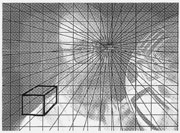 | ||
Two Point Perspective | |||
Two point perspective uses two of these three sets of parallel lines of the cube. It projects one set of parallel lines to the North point and the second set of parallel lines to the East vanishing point. In two point perspective, the third set of lines continues to run parallel. In this case, they run straight up and down. Notice the two points we are using, North and East, are 90 degrees of our horizon. This HORIZON LINE is also the EYE LEVEL LINE. The eye is better to use because if you are underground or in outer space there is no such thing as a horizon but there is always a location of your eyes (eye level). | 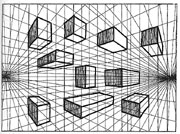 click on picture to print out your own two point grid click on picture to print out your own two point grid | ||
Three Point Perspective | |||
Three point perspective uses all three sets of parallel lines of the cube. Similar to two point perspective, one of the sets of parallel lines aims toward the North point and the other set aims toward the East point. The third set of lines projects toward the Nadir point (below you) or the Zenish point (above you). Either Zenith or Nadir can be used with the same grid by spinning the three point perspective grid 180 degrees. You can project all of these lines with a straight edge. | 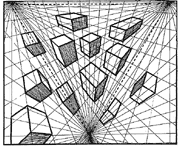 | ||
Four Point Perspective | |||
Four point perspective can be thought of in a couple of different ways. First, we use the same logic it takes to get to three point perspective. But if the cube we are looking at is very tall and projects above you and also goes below your eye level, these up and down lines must project toward two points. Not only does the cube look fat in the middle, it also seems to get smaller as it goes above and below your eye level. These lines, which used to be the up and down parallel lines of the cube, are now curving in like a football coming together at the Zenith and Nadir points. If you were on the twentieth floor of a skyscraper, looking out the window at another skycscraper, forty stories high, you would see this type of effect. | 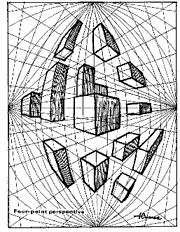 | ||
Five Point Perspective | |||
This system of perspective, using five points, creates a circle on a piece of paper or canvas. You now can illustrate 180 degrees of visual space around you. It captures everything from North to South and from Nadir to Zenith. Think of yourself inside a really exciting visual environment like St. Peter's Basilica in Rome. You bring a transparent hemisphere with you. When you find a spot in the Basilica where any direction you look is visually exciting, you put the hemisphere in front of your face and copy what you see on the inside of it. The hemisphere shows five vanishing points, north, on the left, east in the middle and south on the right. There is also a point above your head and another below your chin. One hundred and eighty degrees of the total environment can be drawn in this hemisphere. Think of how this would look on the flat surface. You would have to rely on five point grid system on the flat page to do the same thing, but it really will work. | 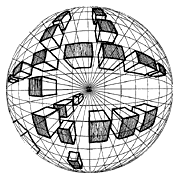 | ||
Six Point Perspective | |||
The sixth (South) point is missing from five point perspective drawings. Within five point we get half, or a hemisphere, of the visual world around us. To get the rest of the picture, the the whole picture that is, you must add that last vanishing point. You would have to turn around and look at the room BEHIND you to see the rest of the room and to find that last point. If you were in the transparent sphere in St. Peter's Basilica you would have to copy not only what you see in front of you, but everything behind you as well. A good way to do this on flat paper is to draw the last vanishing point on the back side of the first drawing. Yes, I mean on the back side of your first drawing. The same grid will help you finish the total picture on this back side. When the rest of this picture is drawn you have a 360 degree picture in all directions. | 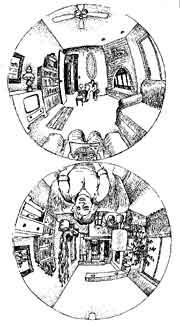 | ||
Thursday, November 1, 2007
So many ways to draw the world around you
Subscribe to:
Post Comments (Atom)

No comments:
Post a Comment